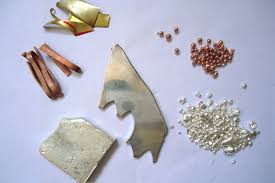Jewelry making is a captivating blend of art and engineering. Whether you’re an aspiring artisan or a seasoned pro, the materials you choose can significantly impact your creations. From gleaming gold to sturdy stainless steel, each option has unique characteristics that influence design, durability, and wearability. As private label jewelry manufacturers continue to rise in popularity, understanding these materials becomes essential for anyone looking to create stunning pieces that stand out in the market.
Pros and Cons of Different Materials
When exploring jewelry-making materials, each option brings its own set of advantages and drawbacks.
Stainless steel is renowned for its strength. It’s resistant to tarnishing and corrosion but can feel a bit heavy compared to other metals.
Brass offers an affordable alternative with excellent malleability, making it easy to shape into intricate designs. However, it may require more maintenance as it can tarnish over time.
Silver is cherished for its classic appeal and shine. Its beauty makes it a favorite, but silver tends to be softer than other materials, increasing the likelihood of scratches.
Gold stands out as the epitome of luxury. It’s durable and hypoallergenic but comes at a higher price point that might not fit every budget.
Understanding these pros and cons helps in selecting the most suitable material for your creative projects. Each choice reflects different values in design and practicality.
Stainless Steel: Strength and Durability
Stainless steel is a favorite among jewelry makers for its remarkable strength. This material can withstand the rigors of daily wear, making it ideal for those who lead active lifestyles.
Its resistance to tarnish and corrosion adds to its appeal. Unlike silver or brass, stainless steel maintains its shine over time without extensive maintenance.
Another advantage is its hypoallergenic properties. For individuals with sensitive skin, stainless steel offers a safe option that minimizes allergic reactions.
Designers love the versatility of this material. It can be polished to a high sheen or finished with a matte look, allowing for various styles.
Brass: Affordable and Versatile
Brass is a favorite among jewelry makers for its affordability and versatility. This metal, an alloy of copper and zinc, offers a rich golden hue that appeals to many.
Its lightweight nature makes it easy to work with. Artisans can create intricate designs without the worry of excess weight. Brass also takes on various finishes well, from polished shine to antique patinas.
Another advantage is its ability to mimic more expensive metals like gold. This quality allows designers to craft stunning pieces at a fraction of the cost.
Silver: Timeless Elegance
Silver has long been celebrated for its radiant beauty and versatility. This precious metal carries an inherent luster that captures the light beautifully, making it a favorite among jewelry makers.
Its malleability allows artisans to create intricate designs, from delicate chains to bold statement pieces. Silver is not just about aesthetics; it’s also affordable compared to gold or platinum, enabling more people to enjoy fine jewelry.
Gold: Classic Luxury
Gold has long been synonymous with luxury and sophistication. Its rich hue captivates the eye, making it a timeless choice for jewelry enthusiasts.
When you think of gold, images of opulence and prestige often come to mind. Whether it’s in simple bands or intricate designs, gold adds an undeniable allure to any piece.
One of its standout qualities is malleability. Gold can be shaped into delicate forms while retaining strength. This versatility allows artisans to create stunning pieces that are both unique and durable.
Choosing the Right Material for Your Project
Choosing the right material for your jewelry project can greatly influence its final look and feel. Each material carries unique characteristics that set it apart from others.
Consider the purpose of your piece. Will it be worn daily or only on special occasions? For everyday wear, opt for durable materials like stainless steel.
Think about your target audience too. If you’re catering to a budget-conscious crowd, brass might be an appealing choice due to its affordability.
Aiming for elegance? Silver offers a timeless charm that many adore.
If luxury is what you’re after, gold never goes out of style and adds significant value to any design.
Don’t forget about color schemes as well; some materials lend themselves better to specific aesthetics than others. Take time to visualize how each option aligns with your creative vision before making a decision.
Tips for Working with Various Materials
When working with different jewelry materials, it’s essential to understand their unique properties. Each material responds differently to tools and techniques.
For stainless steel, use high-quality saw blades for precise cutting. Its toughness can quickly dull inferior tools.
Brass may tarnish over time, so consider applying a protective coating after crafting your pieces. This will help maintain its shine longer.
Silver requires gentle handling; it’s soft and easily scratched. Always keep it stored separately from other metals to avoid damage.
Gold is malleable but can be tricky when soldering due to its high conductivity. Work in small sections for better results.
Experimentation is key! Don’t hesitate to mix materials for an innovative approach. Combining textures or colors can create stunning designs that stand out in the market of private label jewelry manufacturers.
Care and Maintenance of Jewelry Materials
Caring for your jewelry materials is essential to keep them looking their best. Each material requires different attention and storage methods.
Stainless steel, known for its durability, needs minimal care. A simple wipe with a soft cloth will remove fingerprints and dirt.
Brass can tarnish over time. Regular polishing with a brass cleaner helps maintain its shine. Store it in an airtight container to reduce oxidation.
Silver requires more diligence due to its tendency to tarnish quickly. Clean it regularly using silver polish or a dedicated cleaning cloth.
Gold is relatively low-maintenance but still benefits from occasional cleaning with warm soapy water and a gentle brush. Avoid harsh chemicals that could damage the finish.
Regardless of the material, storing jewelry separately prevents scratches and tangling. Keeping pieces away from direct sunlight also preserves their luster for years to come.
Conclusion
When it comes to jewelry making, selecting the right material is crucial. Each option offers distinct advantages and characteristics that cater to different styles and budgets. Stainless steel stands out for its strength and durability, making it an ideal choice for everyday wear. Brass offers versatility at a lower price point, while silver provides a timeless elegance suitable for any occasion. Gold remains the epitome of luxury, appealing to those who appreciate classic beauty.






